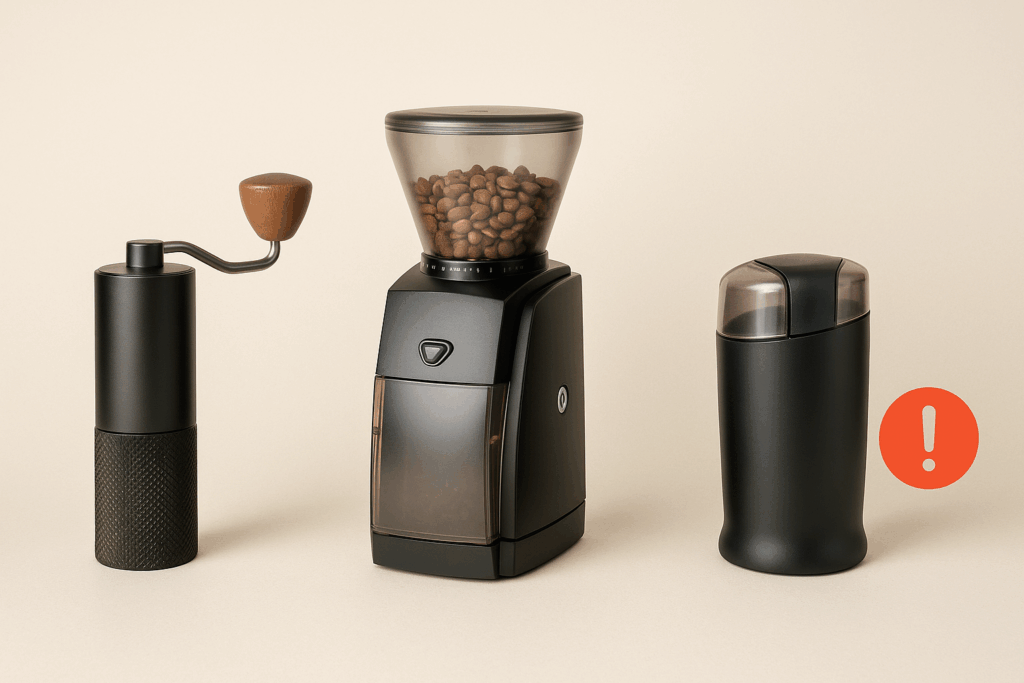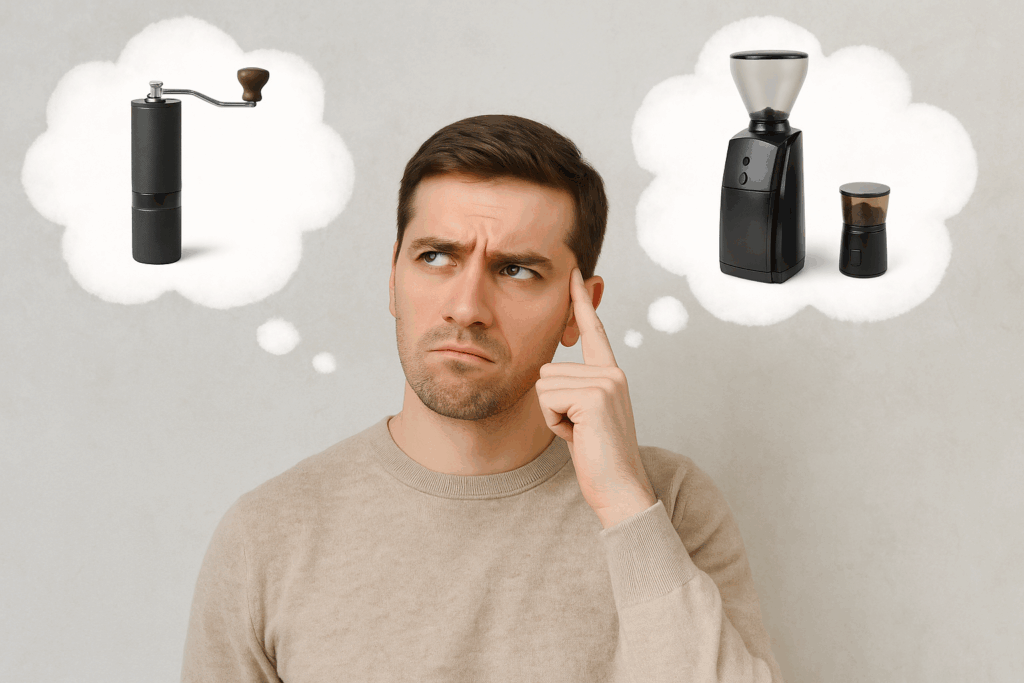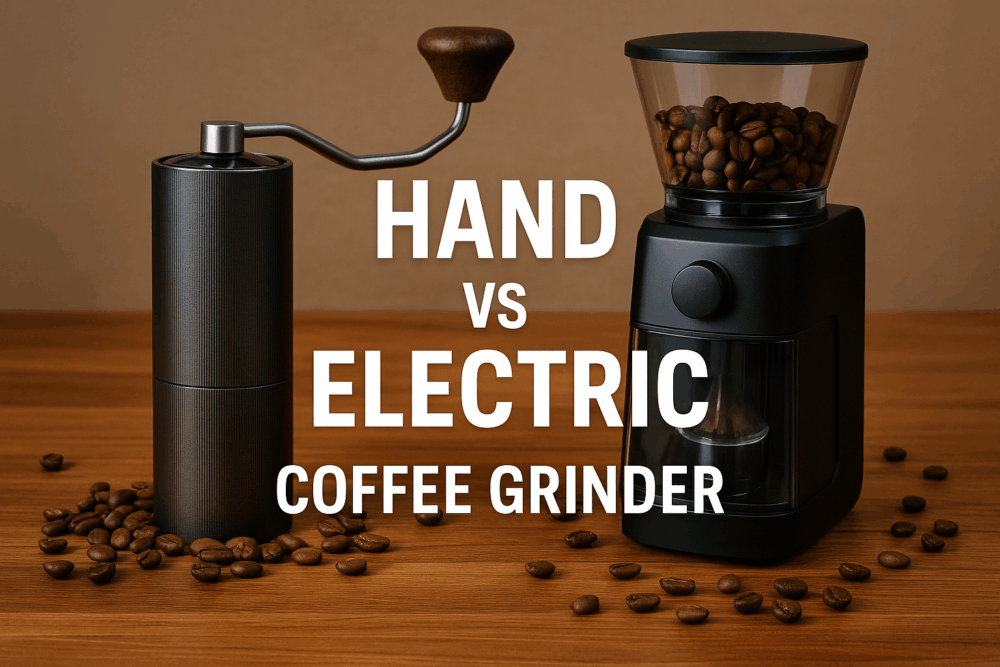Fresh coffee starts with freshly ground beans. If you’ve ever brewed a cup at home and wondered why it doesn’t taste quite like the café version, the answer often lies in the grinder. Grinding beans just before brewing preserves aroma, boosts flavor, and gives you control over the strength of your cup. But here’s the big question: hand vs electric coffee grinder – which one should you choose?
This guide breaks it down in simple terms, covering why grinders matter, the types available, their pros and cons, and which grinder makes the most sense for your budget and brew style. Whether you’re just starting out or looking to upgrade, you’ll walk away knowing exactly what suits you.
Table of Contents
Why a Grinder Matters (The Basics)
A grinder isn’t just another gadget – it’s the foundation of better coffee. Here’s why:
- Freshness first: Coffee beans contain delicate oils and aromatics that create flavor. As soon as beans are ground, they start to lose these aromas through oxidation. Grinding right before brewing locks in freshness.
- Consistency matters: Even grind size means even extraction. If grounds vary from powder to chunks, hot water extracts too much from some bits (bitter) and too little from others (sour). The result is unbalanced coffee.
- Control over flavor: Espresso needs a fine grind (like table salt). French press needs a coarse grind (like sea salt). With your own grinder, you can match grind size to the brewing method.
- Bonus reason: Grinding is part of the ritual. When you grind your beans, you’re not just making coffee—you’re making it yours.
According to the Specialty Coffee Association of Europe (SCAE) Gold Cup Grinding Research Report in 2017, grind consistency directly impacts flavor clarity, body, and balance in the cup. In other words, the grinder you choose matters as much as the beans you brew with.
The Three Types of Coffee Grinders You Need to Know

Not all coffee grinders are created equal, and choosing the right one can dramatically change your coffee experience. Below, we’ll break down the three main types: hand (manual) burr grinders, electric burr grinders, and blade grinders. Each has unique strengths and drawbacks depending on your budget, lifestyle, and brewing style.
Hand (Manual) Burr Grinder
Hand grinders work by turning a handle that rotates burrs (metal or ceramic discs) to crush beans evenly. They’re affordable (€30–150 for good ones), compact, quiet, and perfect for brewing 1–2 cups at a time. Because they produce a consistent grind with very little leftover coffee (low retention), they’re excellent for pour-over, AeroPress, or French press.
The trade-off? They require effort and time (30–90 seconds per dose), and grinding for espresso can be challenging since denser beans take more force. Still, they’re a fantastic option for beginners, hobbyists, or travelers who don’t mind the hands-on process.
Electric Burr Grinder (Conical or Flat Burrs)
Electric burr grinders use a motor to spin burrs that crush beans quickly and evenly. Conical burrs are common in-home grinders, while flat burrs are often found in higher-end café equipment. They’re consistent, fast, and versatile, making them ideal for daily brewers and especially for espresso, where precision matters.
The downside is price (€150–700+), noise, and counter space. Some models also retain more grounds unless specifically designed for single-dosing. But for anyone serious about coffee and looking for convenience, electric burr grinders are the gold standard.
Blade Electric Grinder (Budget, but Not Recommended)
Blade grinders chop beans with fast-spinning blades, much like a blender. They’re cheap (€20–40) and easy to find, but the grind is extremely uneven — with “coffee dust” and big chunks in the same batch. This inconsistency makes it difficult to brew balanced coffee, no matter how good your beans are.
They can work for someone on a very tight budget, but if you care about flavor and consistency, upgrading to a burr grinder (manual or electric) is strongly advised.
Hand vs Electric Coffee Grinder: Quick Comparison
Not sure which grinder is right for you? Here’s a quick side-by-side overview:
| Hand / Manual Burr | Electric Burr (Conical or Flat) | Blade (Electric) | |
| Price range | €30 – €150+ | €150 – €700+ | €20 – €40+ |
| Grind consistency | Very good | Excellent | Poor |
| Effort required | Manual, slower | Automatic, fast | Automatic, fast |
| Noise level | Quiet | Relatively loud | Loud |
| Capacity | 1-2 cups | Single or multiple cups | Multiple cups |
| Best for | Beginners, travelers | Espresso lovers, daily brewers | Tight budgets only |
| Main downside | Slower, effort | Higher cost, takes space | Uneven grind |
If you’d like a visual, in-depth comparison, coffee expert James Hoffmann explains the pros and cons of grinders in his video: A Beginner’s Guide to Coffee Grinders.
Extra Factors Beginners Should Know
- Bean density: Light roasts are denser (harder to grind), while dark roasts are softer. A hand grinder can feel tougher with light roasts.
- Moisture and freshness: Fresher beans may release CO₂ when ground, affecting extraction. Let beans “rest” a few days after roasting.
- Retention: Some grinders trap leftover grounds inside. This can slightly affect your next cup’s flavor and accuracy. Hand grinders usually have less retention.
- Static & clumping: Dry air causes static; ultra-fine espresso grinds can clump. Spritzing beans with a tiny drop of water (called RDT) reduces static.
- Grind steps: Some grinders use fixed “clicks,” others are stepless. Stepless allows finer adjustments – useful for espresso dialing.
- Cleaning: Coffee oils go rancid. Brush burrs weekly and deep clean monthly to keep flavors fresh.
When to Choose a Hand vs Electric Coffee Grinder?

Pick a Hand Grinder if…
Pick an Electric Burr Grinder if…
- You make 1-2 cups at a time.
- You enjoy the ritual and don’t mind some effort.
- You brew mostly filter coffee (pour-over, French press).
- You drink espresso and don’t mind the effort for fine grinding.
- You want something compact and affordable.
- You drink espresso often.
- You brew daily and want speed and consistency.
- You want precise control without manual effort.
- You have the budget and counter space.
Skip Blade Grinders if you can.
They’re better than nothing but inconsistent compared to burr options.
FAQs: Hand vs Electric Coffee Grinder
Q: Do I really need a grinder?
A: Yes. It’s the single biggest upgrade for better coffee at home.
Q: Are hand grinders too slow?
A: They take longer but are fine for 1-2 cups. Many people enjoy the ritual.
Q: Can a hand grinder do espresso?
A: Some can, but it’s more work. An electric burr is more efficient for daily espresso.
Q: Blade grinder or pre-ground?
A: Blade is still better than pre-ground – but burr grinders are a game-changer.
Q: Conical vs flat burrs – what’s better?
A: Both can be excellent. Conical burrs are efficient and affordable; flat burrs are prized for clarity but often pricier.
Conclusion: Hand vs Electric Coffee Grinder
So, hand vs electric coffee grinder – which should you pick? If you’re brewing 1-2 cups of filter coffee and want great value, a hand grinder is compact, affordable, and delivers consistent results. A hand grinder can also work for espresso if you’re on a budget and don’t mind the extra effort. If you brew daily, love espresso, or want speed and convenience, an electric burr grinder is worth the investment. Either way, grinding fresh is the step that transforms your coffee from average to café-quality at home.
Ready to upgrade? Check out these beginner-friendly grinders on Amazon:
- Hand grinder: TIMEMORE Chestnut C2S Manual Coffee Grinder
- Electric flat burr grinder: DF54 Single Dose Coffee Grinder
- Electric conical burr grinder: Baratza Encore Coffee Grinder
Looking for more beginner coffee tips? Explore the Yumm Coffee’s coffee blog for guides and recipes.

Leave a Reply